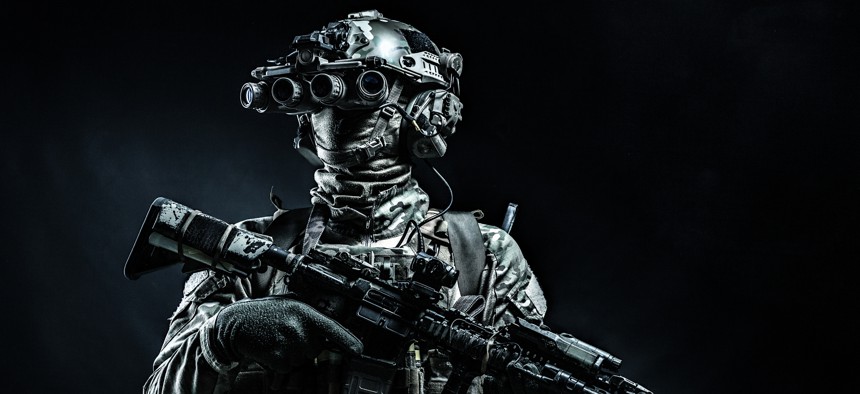Enhancing Soldier Systems
Equipping Soldiers with Innovative Technologies for the Future Fight
The DoD’s 2022 National Defense Strategy spotlights China and Russia as potential military opponents and emphasizes that the US military must be prepared for combat with these near-peer adversaries. More than just possessing a larger military, the US must leverage the latest technology innovations to maintain military superiority. As the US military steps up efforts to modernize combat capabilities, the dismounted soldier remains an essential asset to the success of combat operations. Equipping soldiers with state-of-the-art technology and tools enhances their ability to maneuver, communicate, detect threats, and defeat enemies at faster speeds and greater distances than ever before. This issue brief highlights the latest technologies and tools that will provide soldiers with an edge on the battlefield.
Mixed Reality Training
As the military capabilities of potential adversaries improve, so too must our military’s ability to train and match these challenges. This means that readiness must be a top priority for the US military. Thankfully, technological innovations, made possible by advanced computing and 5G networks, are providing the necessary tools to conduct immersive training simulations that better prepare troops for the threats that await them.
In cooperation with private industry, the US military is leveraging innovations in virtual reality (VR) and augmented reality (AR) to develop immersive training technology that blends the real and virtual worlds. VR offers a three-dimensional, computer-generated environment which can be explored by a user, while AR merges the real world with virtual objects or assets. More advanced than the outdated virtual simulators of the past, the US military is now employing mixed reality (MR) training that utilizes both AR and VR to produce new environments where physical and digital entities co-exist.
The benefits of mixed reality training are manifold: 1) Rather than facing ‘notional’ enemies and threats in a traditional training exercise, VR and AR create a more accurate simulation of dangerous combat scenarios without risk of injury or death. For example, virtual simulations of counter ambush, IED deactivation, or first response procedures can better prepare soldiers for the real life scenario. 2) While traditional training scenarios are often limited by location, cost, and logistics, VR and AR allow soldiers to train at more convenient times and in a variety of locations. 3) VR and AR enable soldiers to repeat training scenarios at greater speeds and review after-action data. Sensors detect physiological and cognitive data (e.g. eye focus and heart rate) along with other performance data that can be reviewed after a training session. 4) VR and AR training can reduce costs. Virtual simulations can often be more affordable than the cost of live ammunition, fuel, and logistics for live-fire exercises.
Innovation Spotlight: Integrated Visual Augmentation System (IVAS)
The US Army’s Synthetic Training Environment Cross-Functional Team (STE-CFT) is developing cutting-edge wearable goggles that combine virtual simulations with real-world training exercises. The Integrated Visual Augmentation System (IVAS) goggles train soldiers via augmented reality, overlaying virtual threats during live training exercises. Holograms displayed on the goggles react to a user’s actions. The IVAS also uses virtual projections to show 3D replays of a training exercise, allowing a team to review the training event in their after-action report.
Advanced Communications
Another method of ensuring US dominance on the battlefield is by enhancing our ability to communicate. Battlefield threats can change rapidly, so precise communication across all domains — air, land, sea, space, and cyberspace — provides decision-makers with the real-time data needed to make the best possible decisions. This capability is fundamental to success in combat. Therefore, the DoD seeks to connect intelligence, surveillance, and reconnaissance sensors across all its military branches into a single network known as Joint All-Domain Command and Control (JADC2). With an eye toward the future, the US Army is working to equip soldiers with the latest tools that will connect them to the JADC2 network and enable precise, real-time communication.
Advancements in battlefield networks and portable communications systems are providing soldiers with the most powerful weapon in their arsenal — access to information. Body-worn communications systems, like radios or GPS-enabled devices, linked with advanced communication networks, enable soldiers to locate friendly forces, identify targets, request medical aid, call in artillery or an airstrike, and more. This capacity to increase situational awareness, improve coordination, and share real-time intelligence presents a clear advantage in combat. Ultimately, a more connected warfighter is a more lethal warfighter.
For nearly a decade already, the Army has outfitted soldiers with the Nett Warrior system to provide them a tactical advantage on the battlefield. Nett Warrior is a system worn by soldiers that consists of a radio, battery, cables, and GPS-enabled end-user device (EUD). Equipped with the Tactical Assault Kit (TAK) software suite, this system connects the dismounted soldier to the Integrated Tactical Network (ITN), enabling them to send and receive data and observe unit location on the battlefield.
“It’s 100 times better, … the ability to pull down your [end-user device] and get a visual confirmation of where all of your units are in space and time on the battlefield.” - Lt. Col. Andy Harris, 1st Battalion Commander, 504th Infantry Regiment
Innovation Spotlight: MCN-AE
The Modular Communications Node-Advanced Enclave (MCN-AE) is a small form factor system that allows soldiers to communicate over secure networks, even on the battlefield. Traditionally, soldiers performing tactical, intelligence, logistics, and medical operations have been required to use separate communications networks to relay information. The Army is using MCN-AE to converge these networks into one tactical network. The MCN-AE also enables commanders conducting operational missions to dynamically assign bandwidth between their tactical mission command and intelligence assets as they see fit, with the ability to reassign additional bandwidth on demand. Also highly portable, the MCN-AE fits into a suitcase-sized case.
Automation/Robotics
Automation and robotics are another source of innovation that’s gaining momentum in the US military. While full realization and deployment of militarized robots is still several years away, the US Army is equipping its soldiers with autonomous tools and robotics to aid with a variety of battlefield scenarios, including reconnaissance, transportation, and explosive disposal.
For example, the US Army is training Quadrupedal Unmanned Ground Vehicles (Q-UGVs) to take the place of soldiers on patrol. While the Q-UGV can be outfitted with weapons, its primary uses are detection, reconnaissance and mapping. The Army is also continuing development of the Robotic Combat Vehicle-Light (RCV-L). This unmanned combat vehicle can transport over 3,000 kg of heavy equipment and can be modified with several mounted weapons, greatly increasing soldier mobility and lethality in combat. The Army is also using robotics to keep soldiers out of harm's way when removing improvised explosive devices (IEDs). The Common Robotic System - Heavy (CRS-H) has the capability to detect, identify, access, and render safe heavy explosive ordnance.
Innovation Spotlight: Black Hornet Drone
The Black Hornet personal reconnaissance system is a miniature drone used by dismounted soldiers to boost situational awareness on the battlefield. Easily carried by soldiers, this pocket-sized UAV weighs roughly 1.16 oz (33g), has a flight endurance of 25 minutes, and has a range of 1.24 miles (2 kilometers). The Black Hornet can be launched in under 2 minutes and generates minimal noise making it ideal for stealth operations. Operated by a lightweight, body-mounted control system, the Black Hornet can hover or fly designated routes while capturing still images and live videos. The Black Hornet is a true force multiplier for the dismounted soldier.
Industry Perspective
Military teams on the move are overloaded with systems that lack integration and cause increasing size, weight, and power challenges. Providing frontline warriors with unmatched situational awareness and communication abilities will transform close-combat warfare. Booz Allen has developed mission solutions that enhance mobility and capability through open, connected squad architectures that allow for rapid integration of new technology—without vendor lock-in.
A warfighter-centric approach that connects sensors and weapon systems across the joint force will rapidly deliver the right data at the right time to soldiers at the tactical edge. Here are our top three priorities for digital battlespace transformation:
- Human-machine partnering – Warfighters will gain the bird’s-eye view of a drone, the close-up vision of a mobile ground robot, and the watchful intelligence of an AI asset. User-friendly, lightweight, fully integrated tech increases the survivability and lethality of close-combat teams, enabling warfighters to share information securely, make decisions rapidly, and take fast, effective action.
- Warfighter Performance – Open-source integration opens a path of continual improvement, allowing teams to incorporate new technologies and adapt to constant change. Squads will move faster with user-friendly tech that makes a shared power source practical — a way to simplify operations and prioritize critical equipment.
- Data Analytics – Smart analytics through a reliable wireless tactical network connected to long-range networks will allow frontline forces to receive and process information from multiple sources. Soldiers will gain greater situational awareness, sharing critical intelligence seamlessly across services and in the mission partner environment.
These mission solutions offer a powerful result: faster upgrades to maintain ongoing, decisive overmatch in the future battlespace. To learn more about Booz Allen’s Digital Warrior Solutions, click here.
Final Considerations
Advanced training capabilities, improved communication networks, and futuristic robotics are all playing a substantial role in enhancing soldier lethality and ensuring they are prepared for potential near-peer fights of the future. These innovations may offer an advantage over opponents at the moment, but potential adversaries like Russia and China are also investing in similar technologies. Further innovations and investments are needed to ensure the US military maintains its global military dominance.
About GBC:
As GovExec’s research division, Government Business Council (GBC) is dedicated to advancing the business of government through analysis, insight, and analytical independence. An extension of Government Executive’s 50 years of exemplary editorial standards and commitment to the highest ethical values, GBC studies influential decision makers from across government to produce intelligence-based research analysis.
For more information, email us at research@govexec.com or visit our website at https://www.govexec.com/insights/?org=gbc.
About Booz Allen Hamilton:
Booz Allen is the premier digital integrator for the DOD, blending decades of mission experience with state-of-the-art technology to help achieve decision advantage. We design open architectures to avoid vendor lock, lower lifecycle cost, and maintain a technological edge. Our technologists work hand-in-hand with our domain experts to build solutions that deliver the warfighter mission-critical information in today’s digital battlespace. We're accelerating innovation to help defend the nation.
Learn More at: boozallen.com/defense
This post is written by Government Business Council; it is not written by and does not necessarily reflect the views of Government Executive Media Group's editorial staff. For more information, see our advertising guidelines.





